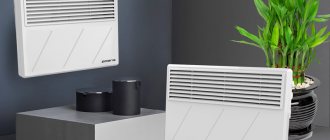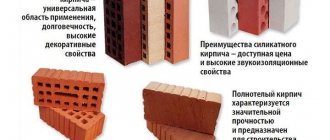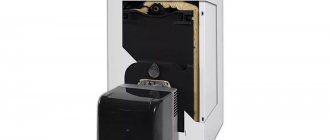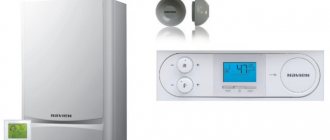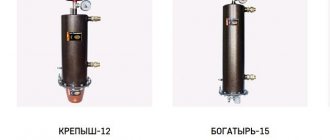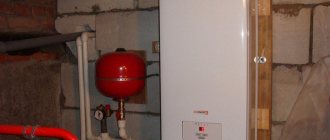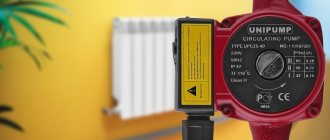With the cold weather approaching, have you thought about buying a device for heating a room with minimal fuel consumption? You've heard that a catalytic gas heater is compact and quite efficient, but, unlike most gas appliances, it is absolutely safe. Is this really true? Agree, buying an expensive “pig in a poke” is not in your plans.
We will help you understand this type of heaters - in our publication we will talk about the design features and operating principles of catalytic devices. Let's look at how they provide high thermal efficiency and provide recommendations for choosing the appropriate model. We will also pay attention to the best manufacturers who have received the largest number of positive reviews from customers.
Heat pumps
The most universal alternative heating for a private home is the installation of heat pumps.
They work on the well-known principle of a refrigerator, taking heat from a colder body and releasing it in the heating system. The circuit is complex at first glance and consists of three devices: an evaporator, a heat exchanger and a compressor. There are a huge number of options for implementing heat pumps, but the most popular are:
The cheapest implementation option is air-to-air. In essence, it resembles a classic split system, but electricity is spent only on pumping heat from the street into the house, and not on heating air masses. This helps save money while keeping your home perfectly warm throughout the year.
The efficiency of the systems is very high. For 1 kW of electricity you can get up to 6-7 kW of heat. Modern inverters work great even at temperatures of -25 degrees and below.
“Air-water” is one of the common implementations of a heat pump, in which the role of a heat exchanger is played by a large-area coil installed in an open area. Additionally, it can be blown by a fan, causing the water inside to cool.
Such installations are characterized by a more affordable cost and simple installation. But they are capable of operating with high efficiency only at temperatures from +7 to +15 degrees. When the bar drops to a negative level, efficiency drops.
The most universal implementation of a heat pump is “ground-water”. It does not depend on the climate zone, since a layer of soil that does not freeze throughout the year is available everywhere.
In this scheme, the pipes are immersed into the ground to a depth where the temperature is maintained at 7-10 degrees throughout the year. Collectors can be located vertically or horizontally. In the first case, it is necessary to drill several very deep wells, in the second, to lay the coil at a certain depth.
The disadvantage is obvious. complex installation work that will require high financial investments. Before deciding to take such a step, you should calculate the economic benefits. In areas with short, warm winters, it is worth considering other options for alternative heating of private houses. Another limitation is that a large free area is required - up to several tens of square meters. m.
The implementation of a water-to-water heat pump is practically no different from the previous one, however, the collector pipes are laid in groundwater, which does not freeze throughout the year, or in a nearby body of water. It is cheaper due to the following advantages:
- Maximum well drilling depth – 15 m
- You can get by with 1-2 submersible pumps
Biofuel boilers
If there is no desire and opportunity to equip a complex system consisting of pipes in the ground, solar modules on the roof, you can replace the classic boiler with a model that runs on biological fuel. They require:
It is recommended to install such installations in conjunction with the previously discussed alternative sources. In situations where one of the heating devices does not work, you can use the second one.
When deciding on the installation and subsequent operation of alternative sources of thermal energy, it is necessary to answer the question: how quickly will they pay for themselves? Of course, the systems considered have advantages, including:
- The cost of energy produced is less than using traditional sources
- High efficiency
However, you should be aware of the high initial material costs, which can reach tens of thousands of dollars. The installation of such installations cannot be called simple, so the work is entrusted exclusively to a professional team that can provide a guarantee on the result.
Alternative heating of a private home is becoming in demand, which is becoming more profitable against the backdrop of rising prices for traditional sources of thermal energy. However, before you start converting your current heating system, you need to calculate everything by considering each of the proposed options.
It is also not recommended to abandon the traditional boiler. It must be left and in certain situations, when alternative heating does not fulfill its functions, it will remain possible to warm your home and not freeze
How to choose a burner
If you plan to use the device exclusively as a camping or fishing heater, feel free to look for small-sized models that will provide enough heat and save you in a critical situation. Don't count on more power as we sacrifice it in terms of weight and size.
For domestic needs, take large models - they have a powerful catalyst, a heat fan and are economical in fuel consumption. Also, such devices are always equipped with fuses so that the equipment can be left unattended. For transportation, you can find an option with a chassis or additionally buy a construction trolley.
Catalytic convectors
These devices can operate on electricity, gasoline or gas. Their use is optimal for heating a room of 20 square meters with a power of about 2.9 kW. Gas models are equipped with a fan and are designated “turbo+”.
Catalytic combustion is the use of the principle of “surface combustion”, which is used for flameless gas burners operating on propane-butane; it is characterized by the absence of flame. The process occurs as a result of the oxidation of certain organic compounds in the air.
During combustion, a lot of thermal energy is released, and the degree of heat of the catalyst can be determined by its purple or yellow color. The efficiency is about 80% higher than the same figure for classical devices. Unlike European countries, catalytic convectors have not yet received widespread use among domestic consumers.
Choosing the optimal heater
When choosing a suitable heater, you need to take into account many nuances, evaluate the convenience of the design, functionality, additional features and equipment of the model you like. Let's consider the main criteria for making the right choice.
Criterion No. 1 – place and conditions of application
The first step is to decide on the purposes for which you plan to buy a catalytic device. The optimal type of design and the set of characteristics required in this case depend on where and under what conditions the device will be used.
For outdoor work, small portable devices are designed that easily fit in a backpack and do not depend on the availability of communications.
The main indicators should be selected taking into account the conditions of upcoming operation and the parameters of the heated object. It is necessary to take into account the expected frequency of use, heating area, and preview reviews of real customers about the model.
So, to heat rooms, it is worth buying larger heaters with sufficient power and automatic safety sensors. If the device will need to be moved frequently, it is better to choose a mobile design on wheels.
Criterion No. 2 – technical characteristics
One of the main parameters of a heater is power. To choose a device with the correct performance, you should perform preliminary calculations, consult with the seller, and carefully study the instructions. The technical documentation must indicate what area the power of a particular model is designed for.
In addition, you need to pay attention to the following characteristics:
- gas consumption - how much fuel is required for operation, is the device economical;
- dimensions - what is the width, length and height of the device, is there enough space in the room to provide free space around it (1.5 m in the front, 0.2 m in the back and sides);
- control type - mechanical or electronic;
- the weight and volume of the intended cylinder - is the device too heavy, how difficult will it be to move and install.
It is important to check the packaging and its compatibility with the equipment. The standard kit includes a reducer, a gas hose, and sometimes a cylinder. If any of the elements do not fit with the device, you must purchase suitable adapters.
The range of catalytic heaters includes models with different performance ranges. Devices with a power of up to 2.9 kW are capable of heating an area of 30-35 m². Power of about 4 kW is suitable for rooms up to 60 m². There are also low-power devices that heat no more than 12 m². Their productivity is about 1.2 kW
It is desirable that the heater be equipped with additional design and functionality.
The main additions and features are as follows:
- automatic power control in several modes;
- horizontal position sensor that turns off the device in case of sudden mechanical impact, distortion, or overturning;
- indoor carbon dioxide level control system;
- infrared heating;
- piezo ignition;
- electric turbofan;
- overpressure relief valve.
For greater ease of use, you should choose a device with wheels for free movement, handles, and stand legs that can be installed in different positions.
Cleaning Features
To find out what catalytic oven cleaning is, you must understand how the equipment is equipped to easily remove any contaminants. The main secret of the effectiveness of this method lies in the special structure of the inner walls of the ovens: instead of the usual smooth surface, you will see porous and rough coatings in them.
Although this design of the walls inside the oven is less aesthetically pleasing, it is the porosity that allows you to maintain cleanliness after cooking. When the temperature in the oven rises above 140 degrees, the relief structure absorbs contaminants and promotes their decomposition. As a result, instead of stubborn stains, a small amount of dry organic residue remains inside the oven, which can be easily removed by simply wiping with a dry cloth.
A catalytic oven cleaning system has several advantages and disadvantages. The main advantages of equipment with such functions include:
- the ability to quickly and easily clean ovens and stoves with gas and electric operating mechanisms;
- cleaning from stains and complex contaminants directly during cooking without harm to your dishes. As a result, significant energy savings;
- when cleaning, the walls and front of the oven do not heat up to dangerous temperatures;
- chemical reactions that allow you to quickly clean the inside of the oven will save you time and effort on cleaning;
- the quality of cleaning processes depends on the textured surface of the inner walls, and not on the materials from which the equipment is made, so you can choose a not very expensive oven with a reliable cleaning system.
What disadvantages may you encounter when using ovens with a catalytic stain removal system? Here are the main ones:
Since only some oven walls have a porous surface, you will have to clean the door and interior base yourself. Baking trays and other internal components are also cleaned in the usual way;
complex stains and large stains are completely eliminated only 2-3 times, so the oven will have to be reheated; the catalytic properties of the relief structure of the internal walls will be partially lost if dairy or sweet products come into contact with some areas. Make sure that during the cooking process, dishes of this type do not come into contact with the surface of the oven; Compared to other modern methods, such cleaning is not significantly effective
In addition, after 4-5 years of using the oven, you will have to update the catalytic panels; It is important to remember that ovens of this type are not designed for standard cleaning using hard brushes: if you begin to clean complex stains in this way, you risk damaging the catalytic surface
Attention! If you plan to cook often in a new oven, pay attention to models with double-sided catalytic panels, which will only need to be installed with the reverse side if they lose their cleaning properties. One of the important advantages of this function of ovens is the ability to install built-in appliances in any area of the kitchen, regardless of contact with other household appliances
One of the important advantages of this function of ovens is the ability to install built-in appliances in any area of the kitchen, regardless of contact with other household appliances.
Although catalytic processes require high temperatures, the outside of the ovens will not become hot enough to affect the quality of nearby kitchen appliances. You can save on the purchase of equipment and materials with thermal insulation properties. Another advantage: even cheap versions of modern oven models are equipped with the ability to clean using a catalytic method. For example, you will find a good option among products from Ariston, Electrolux or Siemens.
Now you know what catalytic oven cleaning means. But, since any housewife is interested in getting the best results from the operation of kitchen appliances, we recommend that you familiarize yourself with alternative cleaning options - and make sure that the catalytic method is deservedly considered one of the best.
Types of tent heaters and their design
There are many types of industrial heaters used in camping conditions, with even more classifying characteristics. The main difference between these heaters is the fuel consumed and the heat generation output.
Important!
The use of homemade heaters, especially in tent conditions - with limited living space, is an explosion and fire hazard, so their use is permissible only in extreme situations in the absence of an alternative. In all other cases, only industrial-made devices should be used.
Liquid fuel appliances
Tourist liquid fuel heaters, depending on the design, consume kerosene or gasoline. The calorific value of such devices is quite high, but their operation is accompanied by the following negative factors:
- the combustion of even purified liquid fuel is accompanied by the presence of an unpleasant odor in the air during a certain period;
- The procedure for refueling the heater requires caution to avoid fuel spills;
- not all types of devices have the design possibility of being equipped with a device for automatic combustion termination when tipped over;
- The quality of liquid fuel upon purchase is not predictable.
Kerosene small heaters
Kerosene heaters
camping devices are classified as infrared heating devices, but can also be used for cooking.
The device is a housing, in the lower part of which there is a fuel tank with a filler neck. At the top of the tank, like in a kerosene lamp, there is a wick device with a flame-regulating mechanism. The wick is a sleeve made of special fabric, the lower part of which is immersed in kerosene, and the upper part is located inside a mesh metal cylinder-emitter. The wick is ignited manually or using a piezo device, and after heating the device (5 minutes), its length is adjusted until there is no soot during combustion - in this case, it is not the kerosene that is burned, but its vapor.
The metal mesh (shell) heats up until it glows and begins to emit infrared waves, heating the surfaces of objects along the path of its propagation. You can place metal utensils of a suitable size on the appliance for cooking.
The advantages of such “kerosene stoves”
— compactness, functionality, efficiency, affordable price.
Flaws
– the smell in the air from burning kerosene before the device enters operating mode (the first 5 minutes), the absence of a device for automatically stopping the fuel supply if there is a possibility of capsizing.
Gasoline heaters for tents
Gasoline heaters have been used for a long time to heat temporary light housing, but previously they were primitive devices based on a conventional burner with a high degree of fire hazard during operation.
In the process of improvements, modern gasoline heaters are effective universal devices that consume not gasoline as fuel, but an air-gasoline or air-alcohol mixture.
Small-sized alcohol heaters: on the left is a Dometic Origo 5100 burner, on the right is a Dometic ORIGO A100 stove.
However, the presence of a smell in the air that accompanies the combustion of foreign impurities in gasoline or alcohol makes these devices less in demand.
Multi-fuel burner KOVEA KB-0603, designed for gas or gasoline consumption, included.
More advanced are liquid fuel camping heaters of catalytic action, in which heat is released due to the oxidation of the fuel, but not during its combustion. In such devices, vapors of preheated gasoline or alcohol are supplied to a also heated plate coated with a catalyst, where they are oxidized, releasing heat. Models with a removable hob for cooking are also produced.
Petrol-alcohol catalytic heaters for tents
With a high degree of safety (no open flame), such units have a significant drawback - a limited resource, since during the oxidation process the catalytic substance evaporates under the influence of heat.
Solid fuel units
These devices, as a rule, are not considered as the main ones when solving the issue of heating in a tent or tent, since the limitations in the dimensions of heating devices exclude the possibility of using firewood, and the effectiveness of using solid fuel materials, such as dry alcohol, for example, is not great.
However, as a means for quickly warming hands or warming up a mug of tea, cans of canned food, solid fuel devices are quite suitable.
Gas devices
There are many varieties of gas tent heaters produced, so it is not realistic to present a general description for all such units. Each line of models has individual characteristics, and the only common features of all camping gas heaters are the type of fuel consumed, compactness and efficiency.
A tourist gas heater is most often designed to use disposable propane cylinders inserted into the device body or connected via a hose. But models are produced that can be installed on a standard household cylinder and are also suitable for cooking.
Important!
Due to the physical characteristics of liquefied gas, devices on a standard cylinder are suitable for use at temperatures down to -5 degrees, and this should be taken into account when transporting the cylinder and its installation location. Gas fuel in special cartridges is designed for use at lower temperatures.
In terms of heating method, a portable infrared gas heater is the safest and most effective for use in tents due to the absence of a directed stream of hot air during operation, which is a fire hazard in a small room.
A gas cylinder heater, equipped with a conventional burner without an infrared emitter, is effective when used outdoors, for example, for quick cooking in a boiler.
Infrared heaters for camping conditions are divided into three groups:
- with a metal emitter;
- with ceramic radiation generator;
- catalytic action.
Metal emitter
The gas infrared tourist heater is a steel mesh heated by a burner and equipped with a reflector. The emitter does not come into contact with the burner material and is equipped with a protective mesh for safe use.
Despite the fact that such heaters are universal - they are used both for heating an area of 5-6 square meters and for cooking, the price range of devices with a metal emitter is accessible to a wide range of consumers, but when purchasing, one should take into account their increased gas consumption.
Infrared camping gas heaters with a metal emitter.
Ceramic infrared generator in portable tent heaters
made in the form of a perforated plate, also heated by the flame of a burner, to which a gas-air mixture is supplied. Ceramic infrared gas heaters are intended for heating only; you cannot cook with them, while analysis of statistics on the use of these devices shows a high fire hazard. However, due to their compactness, low weight (on average, 0.7 kg without spare cylinders), minimal emission of gas combustion products and economical fuel consumption, such heaters continue to be widely popular among tourism enthusiasts.
Infrared gas heaters with ceramic emitters: on the left - table-mounted Orgaz Heater SB-602, on the right - floor-standing "Siberian GII-0.8".
Catalytic gas heater
for use in tents and tents - the most advanced device for camping conditions, which has a fiberglass panel with a platinum or cobalt-chrome coating - a catalyst. The conversion of fuel energy into heat in such devices occurs without a combustion process - preheated gas is also supplied to the heated panel, which, in the presence of a catalyst, reacts with oxygen in the air (oxidizes), resulting in the release of energy.
Due to the absence of an open flame during operation and the occurrence of oxidation at a temperature below the combustion temperature, catalytic heaters are the safest for use in cramped tent conditions. In addition, the efficiency of such heaters when converting fuel into thermal energy is around 99%, while that of ceramic radiators is about 50%.
A catalytic tent heater is a silent unit with zero probability of emitting combustion products into the air, but its effect takes some time.
Catalytic gas heating devices cannot be used for cooking, since physical impact on the plate or liquid getting on it can render the catalyst unusable or extinguish the device.
Catalytic heater in action outdoors.
The unit is compact, does not require searching for fuel, but is designed to use disposable cartridges only of a certain type.
The oxidation temperature of fuel is lower than its combustion temperature, but the heater should still not be leaned against flammable objects or touched with bare hands.
The oxidation process is accompanied by the consumption of oxygen from the air in the tent, so it needs to be ventilated periodically, and for safety reasons, it is better to turn off the unit while sleeping.
Important!
The power of some models of catalytic portable heaters from foreign manufacturers is not designed for use in Russian winter conditions. Therefore, special attachments are available for sale for such devices that increase the heat transfer area of the device.
The heater is started by pressing the button of the piezo device or by igniting it with a match.
The price range for catalytic heaters starts from 2.5 thousand rubles.
On a note
To avoid repeating the mistakes of others, it should be noted that using homemade devices powered by batteries or accumulators to heat a tent or marquee is not effective.
At first glance, it seems possible to use heaters based on resistive elements or a self-regulating heating cable for this, but it should be borne in mind that even if the heaters are selected for a battery voltage of 12 V, the battery will need constant recharging. To recharge the battery, you need a generator, which, in turn, needs fuel, and thus the know-how in the form of “battery-powered heating” will turn into a labor-intensive and costly undertaking.
Principle of operation
Thermal energy during catalytic combustion is released as a result of the flameless oxidation of gasoline or liquefied gas vapor on the surface of the catalyst. The operation of an air heater, as this device is often called in everyday life, occurs without the appearance of a flame, the process is considered environmentally friendly and safe. In addition, there is a clear advantage of a catalytic burner over a conventional flame burner in terms of thermal efficiency.
Diagram of operation of a catalytic heater
The advantages of catalytic heat sources include their high fire and explosion safety, and the ability to operate for a long time without human intervention.
To operate the device, liquefied household gas, ordinary propane-butane, can be used. The heating element is a panel made of fiberglass containing a catalyst - platinum powder.
A catalytic heater operating on liquefied gas is used in everyday life for heating:
- dachas and country houses;
- workshops, garages, warehouses;
- construction projects.
The flameless combustion process is highly efficient, and the air in the room is not polluted with harmful impurities and soot.
The model range of the device includes heaters of various configurations, including those that allow the additional use of a fan heater and heating element, which has a significant impact on increasing the power of the catalytic heater to 4.9 kW). Among those presented on today's market, there are gas heaters of a new operating principle based on deep oxidation. They do not contain platinum group metal additives.
Varieties
All catalytic heaters are primarily distinguished by their design features. Monolithic devices are most widespread. In them, the liquefied gas cylinder is located directly inside the body. Depending on the model, the volume of this container can be no more than 27 cubic meters.
Other types of structures do not provide for a housing. They only contain a plate impregnated with catalysts. These models are often used during travel and camping trips to heat cars and tents. They are compact in size and convenient to take with you.
In addition, the devices differ in the type of heating: they can be ordinary or infrared. Infrared gas devices use a ceramic panel for heating. For more efficient and faster heating and to achieve a comfortable room temperature, special reflective plates are installed inside the devices.
Which brand of catalytic emitter is better to choose?
The lineup is represented by only a few manufacturers. As consumer reviews show, the following companies offer good quality products:
- An autonomous small-sized gas catalytic heater for a tent is offered by Campingaz. The Campingaz equipment line includes several different modifications, differing in type of purpose. It is convenient to use the Bluecat model when hiking. Operates on bottled gas. The canister is inserted into the body. Ignition is carried out by a piezoelectric element.
- Catalytic hand warmer using alcohol is a miniature model that fits in the palm of your hand. The Kovea heating pad is popular. The advantage of Kovea products is the thoughtful design and efficient operation of the device. The company also offers special purified industrial alcohol for the heater.
- Portable gasoline catalytic heater for a tent - equipment offered by the American company Coleman, specializing in the manufacture of accessories for tourists. Coleman uses special gas cartridges to operate. Burning time without refueling is 14 hours.
- Equipment for home heating - powerful and efficient installations are offered by Bartolini. The model is equipped with a fan heater and operates in autonomous mode. Used for heating residential premises as a main or auxiliary heat source.
Pros and cons of catalytic heating
The design of the catalytic burner-heater and the heating principle used directly affects the advantages and disadvantages of the equipment. The advantages of heating using a catalyst include the following:
- Has a beneficial effect on the microclimate of the room. The good thing about a catalytic gas heater is that virtually no oxygen is burned during operation and no harmful substances are released.
- Safety - during operation, the occurrence of fire, carbon monoxide poisoning, etc. is excluded. This allows the heaters to be used equally safely both for heating a tent, a private home, or an industrial workshop.
- Autonomy - each heater is equipped with a thermostat that helps set the required power. After switching on, the installation works in offline mode.
- Mobility – even powerful, efficient heaters can be easily moved using wheels on the body. Mobile stations are lightweight and small in size, which allows you to place the heater in a bag or backpack.
There are certain disadvantages of using a catalyst when burning fuel:
- The operating life of the heater is only about 2500 hours. As the catalyst is used, it gradually burns out. Over time, the catalytic panel will need to be replaced, costing approximately ⅔ of the price of a new heater.
- Typical malfunctions are related to the quality of the fuel used. A catalyst running on gasoline or technical alcohol quickly fails if poorly purified fuel is used.
Are catalytic emitters harmful?
No! Heaters that emit infrared waves and use a catalyst to generate heat are not dangerous. Of course, during operation you should follow safety precautions (instructions are given in the instructions).
Operational safety is ensured by the following:
- IR radiation – waves of a certain low spectrum are used, which have a beneficial effect on the human immune and nervous system.
- The operation process uses flameless combustion of fuel through oxidation. As a result, carbon monoxide does not accumulate in the room.
The rules for using the heater prohibit operation of the device in the absence or malfunction of the gas sensor.
Catalytic heaters relatively recently became available to domestic consumers. Heating systems are most popular among outdoor enthusiasts. Heaters using a catalyst are the optimal solution for heating tents and construction sites. Powerful radiators are effective in heating large areas.
Differences from gasoline and multi-fuel models
Gas appliances are the most common, but not the only type of catalytic equipment. Heating units can also operate on other types of fuel.
Depending on this criterion, three more types of devices are distinguished:
- Gasoline . Devices with a built-in fuel tank connected to a catalytic cartridge. Gasoline vapors in them enter the cartridge and undergo oxidation when interacting with the catalyst. Mobility and modest size contribute to the particular popularity of gasoline heaters among outdoor enthusiasts, hunters, and fishermen.
- On technical alcohol . Designs with a special internal compartment into which a container with alcohol or dry fuel is placed. They are presented in small-sized models weighing no more than 1.5-2 kg. They are used exclusively in field conditions: they heat tents, dry clothes, and heat food and drink.
- Multi-fuel . Universal heaters that work with any available type of fuel, both gaseous and liquid. They are characterized by rather limited power - 500-1200 W.
Apart from external characteristics, there are no significant differences between gas, gasoline and multi-fuel catalytic heaters. They all work on the principle of catalytic combustion and have a similar internal structure.
The main advantages of gasoline and multi-fuel models are mobility, compact dimensions, and relatively affordable price. As for technical and operational parameters, gas installations are an order of magnitude superior
Gas appliances are easier to maintain, have high performance, and are designed for a wide range of applications.
Gasoline devices are a little more difficult to operate. To ensure efficient and uninterrupted operation, you need to fill them with gasoline of the highest purity.
Stones
Heating a tent using a stone/stones is an old method, notable for its simplicity and reliability. It is suitable for stronger cold weather than the previous two. But here, as in everything, there are some nuances.
If you just take a heated stone and bring it into the tent, it will be hot, but not for long. In just an hour the stone will cool down and the cold will set in again. The first way to increase the cooling time of the stone is to place it in a kettle and cover it with a lid. Such a simple manipulation will heat the tent for three hours, but this is not enough for a comfortable sleep. It is necessary to slow down the heat transfer of the stone so that it remains hot for at least 6-8 hours. For these purposes, simple aluminum foil is used. It is non-flammable, lightweight and very compact. If you wrap the stone in several layers of foil, it will cool much more slowly and will not create stuffiness in the first hours of cooling. Heat will be retained due to the air gap between the layers. If you feel that it is getting cold in the tent, simply remove one layer of foil.
A hot stone can burn through the bottom of the tent, so it is placed in a kettle or saucepan. It is good if the stone gets stuck in the socket of the container and does not heat its bottom. Otherwise, you need to put a wooden plank under the pan. Another important nuance: do not heat the stone too intensely in the fire. Due to a sharp temperature change on the surface and inside, it may crack.
A canister of hot water works like a stone. Only heat transfer occurs much faster.
Safety precautions
- It is prohibited to remove the protective elements.
- Do not cover the device with cloth or clothing.
- The device must be installed in the position specified in the technical documentation.
- Do not point the infrared heater at the surface of a gas cylinder or fuel supply hose.
- The room should be well ventilated.
- You cannot refill the cylinder yourself or disassemble the equipment.
- The heater must only be connected to the gas pipeline by a specialist from an organization that has the appropriate license.
Infrared heat
IR heaters use the principle of solar radiation. The device first heats objects, and they then give off heat. This heating method does not change the level of air humidity and oxygen content in it. This allows you to stay indoors in comfort at any temperature.
Electromagnetic waves create uniform heating. The heating element is ceramic plates assembled into a reflector. IR heaters are capable of operating in the long-wave or medium-wave range.
Based on their location, such devices are divided into:
- floor;
- wall;
- ceiling
Areas of use
Catalytic air heaters are rarely used for heating residential premises. Unless we are talking about an unfinished private house, where renovations are being done, or people have already moved, and the main heating system has not yet been installed. In this case, the device will become a real salvation. However, there are more common uses:
- Garages
. The heater is able to warm the area of a standard garage, and operation without fire makes it safe to use near cars. - Small workshops
. The catalytic heating method is a real salvation for workers in various workshops. There are fire safety rules there, but there are usually no heating systems. - Tents
_ A catalytic tent heater will provide warmth to tourists who love to spend the night in nature. The camping version weighs a little, but warms an area of about 20 sq.m. - Greenhouses
. An excellent replacement for stoves, now gardeners don’t have to wake up at night to add firewood: the harvest is under reliable protection. - Temporary buildings
. In such buildings this is the only safe way to keep warm.
Use while hiking
If you need the heating pad to heat not all day, but for example, several hours, then refill it at the rate of 1 ml per 1 hour of operation. For reserve, you can add a few milliliters on top.
Despite the fact that the device itself is small in size, it is capable of maintaining heat in a room with an area of 15 to 25 m2. Therefore, the calculation of the number of devices per tent must be carried out based on these indicators.
The order of use is as follows:
- remove the lid from the heating pad, separate the wick;
- fill with fuel using a syringe or funnel;
- after filling the tank, remove the watering can and drain the remaining fuel (droplets that fall on the heater must be thoroughly wiped off);
- place the heating pad vertically and the wick on the filling hole;
- bring the lit lighter to the top of the wick, hold for 5-6 seconds;
- close the tank lid and place the heater in the case.
The heating pad starts working at a temperature of 42-50 degrees. You can regulate the temperature by supplying air. The freer the air access, the higher the temperature will be.
Advantages
- A catalytic gas heater consumes oxygen, but this consumption does not exceed the maximum permissible standards.
- Safety and autonomy. Most models are equipped with a sensor for monitoring the presence of gas in the air, which turns off the device if the maximum value is exceeded.
- Mobility. Large appliances are equipped with 4 wheels, with which even a pregnant girl can move the heater around the room. Before moving the device from place to place, it must be turned off.
- Several operating modes. The Bartolini Pullover K catalytic burner (like many other models) has 3 operating modes with different fuel consumption. With this you can use the heating device more efficiently and economically:
- Mode 1 (1200 W) – fuel consumption 100 g/hour;
- Mode 2 (2400 W) – 200 g/hour;
- Mode 3 (2900 W) – 300 g/hour.
Chenille stove
Furnace-heater “Chinel” The gas-generating furnace-heater “Chinel” is designed for efficient and long-term heating of premises with minimal fuel consumption. One load of fuel is enough for 8-12 hours of operation. This effect is achieved due to the principle of gas generation. When the heater operates in gas generation mode, slow combustion (smoldering) of the fuel occurs due to a decrease in the supply of air oxygen.
The fuel for the Chenille heater stove can be wood waste, wood, peat, cardboard. Kindling is carried out in the same way as in conventional wood-burning stoves and ends when the heater is loaded with fuel, its entire mass is engulfed in flames and burns steadily (approximately 20 minutes), which is determined by the characteristic sound. After finishing the kindling, the heater is switched to gas generation mode, for which it is necessary to close the damper of the smoke exhaust pipe and close the ash damper, moving the damper lever down so that the fuel burns as slowly but steadily as possible.
Additionally, it is possible to cook food with the oven lid open and dry food with the lid lowered. The furnace has a very high efficiency (efficiency 67-75%), so the formation of ash is negligible.
Stove-heater “Chenelle” The stove is designed to quickly heat the air, maintain the desired temperature and heat the water in a bathhouse with a volume of 20 cubic meters. To “heat the bathhouse” and raise the air temperature to approximately 70°C, 30 to 50 minutes is enough. During the same time, the water in the tank heats up to 80 degrees.
Heated room volume: up to 20 cubic meters. m. Design features: all-welded body with a firebox and chimney system and hinged metal body screens. Fuel: firewood, wood waste, peat briquettes. Tank capacity for heating water: 40 l. Dimensions (HxWxD): 554x464x1080 mm; Pipe diameter 140 mm. Weight: 92 kg.
